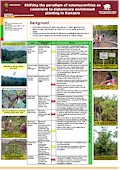| Poster |
 |
|
| Title | Shifting the paradigm of ectomycorrhiza as constraint to dipterocarp enrichment planting in Sumatra | | Author | Made Hesti Lestari Tata, Meine van Noordwijk and Marinus J.A. Werger | | Year | 2008 | | Publisher | World Agroforestry Centre - ICRAF, SEA Regional Office | | City | Bogor, Indonesia | | Call Number | PO0148-08 | | Keywords | biodiversity, conservation, Scleroderma columnare, Shorea, rubber agroforest |
|
| Abstract: |
| Farmer-managed rubber agroforest (RAF) have become a major reservoir of forest biodiversity and other forest services valued in natural forest. Species richness of seedling and sapling stage in RAF was as high as that was in forest; on the contrary species richness of the tree stage in the forest was significantly higher than that was in RAF, as evidence of farmer managed agro-ecosystems by selective culling of ‘poles’ and young trees.
Enrichment planting with dipterocarp trees is emerging as an option for landscape restoration, but its use is constrained by finding ectomycorrhiza (EcM) partner for dipterocarp seedlings. Earlier study in Kalimantan showed that EcM fungi are sensitive to land cover change, particularly to open soil. As consequence, EcM inoculation in nursery stage seedlings is essential in forest regeneration. In contrast, evidence from EcM inoculum potential study in Jambi site showed that EcM inoculums survive in the long term Imperata grassland. Additionally, heating soil at 150 oC for 3 hours did not eliminate EcM inoculum in the soils. The possible explanation is that those EcM fungi were either very persistent species or a very efficient dispersal mechanism.
Basidiomycetes fungi forming EcM, such as Russula, were commonly encountered in mixed dipterocarp forest. It is widely known that Dipterocarp species has a high specificity of tree - fungal relationship, since dipterocarp seeds easily germinate under a mother tree. However, experiment on Shorea out-planting in many treatments and situation showed that five morphotypes of EcM persists in the soils, which may be associated with different group of fungi. Internal transcribe spacer (ITS) sequences of ribosomal DNA of Shorea roots suggests host trees colonized by EcM and root endophyte fungi from Basidiomyetes and Ascomycetes groups.
In contrast to many reports that mycorrhiza essential for nutrient (especially P) uptake, our result showed that inoculation of Shorea seedlings with EcM fungus, e.g. Scleroderma columnare, in nursery stage did not increase N and P total uptake. Inoculation of EcM significantly influenced seedlings early survival, which suggest avoidance of root-born disease as main benefit.
Regarding fungal diversity, we found less evidence on critical loss ecosystem function in agricultural landscape, such as RAF and Imperata grassland. This may be weakening conservation argument; nevertheless this challenges reforestation and agro-reforestation effort. Planting timber is not necessarily requires specialized nursery and technology. |
|
|
Download file(s): Click icon to download/open file.
|
| |
File Size |
Description |

|
558 KB |
Softcopy |
|
|
GRP 1: Domestication, utilization andconservation ofsuperior agroforestry germplasm
GRP 3: Improving tree product marketing for smallholders
GRP 5: Improving the ability of farmers, ecosystems & governments to cope with climate change
|
| Viewed in 1820 times. Downloaded in 382 times. |